The Power of Data Analytics and Insights
Data analytics is revolutionising the way businesses operate and make decisions. By harnessing the power of data, organisations can gain valuable insights that drive strategic planning, improve operational efficiency, and enhance customer experiences.
Through data analytics, businesses can collect, analyse, and interpret vast amounts of information to uncover patterns, trends, and correlations that may not be apparent through traditional methods. This allows companies to make informed decisions based on evidence rather than intuition.
One of the key benefits of data analytics is its ability to provide actionable insights. By examining historical data and real-time information, businesses can identify opportunities for growth, optimise processes, and mitigate risks. For example, retailers can use data analytics to understand customer preferences and tailor their marketing strategies accordingly.
Furthermore, data analytics enables organisations to measure the effectiveness of their initiatives and track key performance indicators (KPIs) in real time. This allows businesses to adapt quickly to changing market conditions and make data-driven decisions that drive success.
In conclusion, data analytics is a powerful tool that empowers businesses to unlock the full potential of their data. By leveraging advanced analytics techniques and tools, organisations can gain valuable insights that drive innovation, improve decision-making processes, and ultimately achieve their business objectives.
Seven Essential Tips for Enhancing Data Analytics and Insights: A Guide to Effective Strategies
- Define clear objectives before starting any data analysis.
- Ensure data quality by cleaning and validating the data.
- Use appropriate tools and techniques for data analysis, such as statistical software or programming languages like Python or R.
- Visualise data to identify patterns and trends more easily.
- Apply different types of analysis (descriptive, diagnostic, predictive, prescriptive) depending on the goals.
- Regularly review and update your analytical models to ensure relevance and accuracy.
- Communicate insights effectively to stakeholders through reports, presentations, or visualisations.
Define clear objectives before starting any data analysis.
Defining clear objectives before embarking on any data analysis is crucial for ensuring the success and effectiveness of the process. By establishing specific goals and outcomes upfront, businesses can focus their efforts on extracting relevant insights that directly contribute to achieving those objectives. This strategic approach not only streamlines the data analysis process but also helps in making informed decisions based on the findings. Setting clear objectives provides a roadmap for the analysis, guiding organisations towards actionable insights that drive meaningful outcomes and business growth.
Ensure data quality by cleaning and validating the data.
To maximise the effectiveness of data analytics and gain meaningful insights, it is crucial to ensure data quality through thorough cleaning and validation processes. By cleaning and validating the data, businesses can identify and rectify errors, inconsistencies, and missing values that could compromise the accuracy and reliability of their analysis. This meticulous attention to data quality not only enhances the credibility of insights derived from analytics but also enables organisations to make informed decisions based on reliable information.
Use appropriate tools and techniques for data analysis, such as statistical software or programming languages like Python or R.
To maximise the effectiveness of data analytics and gain valuable insights, it is crucial to utilise appropriate tools and techniques for data analysis. Employing statistical software or programming languages like Python or R can enhance the accuracy and efficiency of data processing, enabling businesses to extract meaningful information from complex datasets. By leveraging these advanced tools, organisations can uncover hidden patterns, trends, and correlations within their data, leading to informed decision-making and strategic planning that drives success and innovation.
Visualise data to identify patterns and trends more easily.
Visualising data is a crucial step in the data analytics process as it allows analysts to identify patterns and trends more easily. By representing complex datasets graphically through charts, graphs, and dashboards, analysts can quickly spot correlations, outliers, and relationships that may not be apparent from raw data alone. Visualisation not only simplifies the interpretation of data but also helps in communicating insights effectively to stakeholders. This visual approach enhances decision-making processes and enables organisations to make informed choices based on a clear understanding of their data.
Apply different types of analysis (descriptive, diagnostic, predictive, prescriptive) depending on the goals.
When utilising data analytics and insights, it is crucial to apply various types of analysis, including descriptive, diagnostic, predictive, and prescriptive, based on the specific goals of the project or initiative. Descriptive analysis helps in understanding historical data patterns and trends, while diagnostic analysis delves deeper into identifying the root causes of certain outcomes. Predictive analysis enables businesses to forecast future trends and behaviours, while prescriptive analysis provides recommendations on optimal actions to achieve desired outcomes. By incorporating these different types of analysis into data analytics strategies, organisations can make well-informed decisions that drive success and innovation.
Regularly review and update your analytical models to ensure relevance and accuracy.
Regularly reviewing and updating your analytical models is crucial to maintaining their relevance and accuracy in data analytics. By continuously assessing and refining your models, you can adapt to changing trends, market conditions, and business needs. This practice ensures that your insights remain reliable and actionable, enabling you to make informed decisions that drive success and innovation in your organisation.
Communicate insights effectively to stakeholders through reports, presentations, or visualisations.
Effective communication of insights to stakeholders is crucial in the realm of data analytics. By conveying complex findings in a clear and concise manner through reports, presentations, or visualisations, businesses can ensure that key decision-makers understand the implications of the data analysis. This enables stakeholders to make informed decisions based on the insights provided, leading to more strategic and impactful outcomes for the organisation.

No Responses